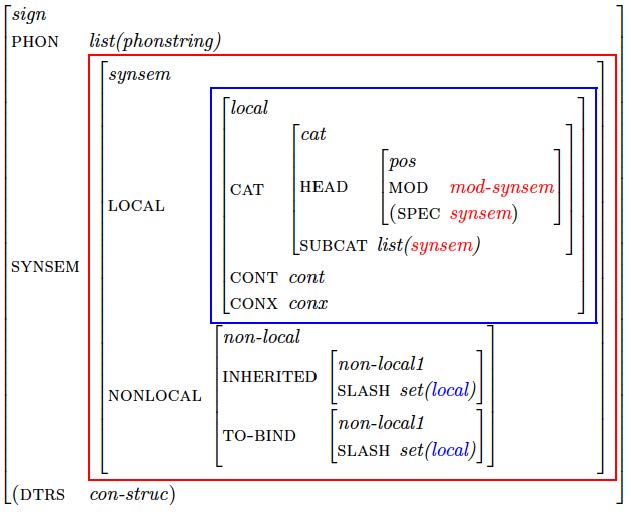User:Gert
Syntax 1 Wiki
Auxiliaries
- Examples: may, can, will, shall, might, could
- English auxiliaries differ from verbs in that they show the following properties, the NICE properties:
- Negation:
A finite auxiliary precedes the negation particle not to negate a sentence.
- Pat will not walk home.
- Pat walked not home.
- Inversion:
A finite auxiliary stands at the beginning of a sentence in yes/no-questions. Will Pat walk home? Walked Pat home? Contraction: There is an idiosyncratic contraction form of the auxiliary and the negation particle. won't, can't Ellipsis: An auxiliary can occur in VP ellipsis, i.e. at the end of a sentence when a VP is missing. Pat should walk home and Mary might, too.
- Pat walked home and Mary, too.
General properties of the modal auxiliaries: no inflection for 3rd singular only a finite form Problematic cases: The verbs be and have have the properties of both verbs and auxiliaries. The support verb do is similar to be and have, but only has a finite form. Infinitival to shows many properties of auxiliaries, and is considered an auxiliary in many theories of grammar.
Conjunctions
Subclasses: Coordinate conjunctions: examples: simple coordinate conjunctions: and, or, but complex coordinate conjunctions: either ... or, neither ... nor coordinate conjunctions link two phrases of the same type. Subordinate conjunctions: examples: since, because, while, although, when, before, after, until, unless, as, if Difference between coordinate and subordinate conjunctions: Pat went to the theater and Chris stayed home.
- And Chris stayed home Pat went to the theater.
Pat went to the theater while Chris stayed home. While Chris stayed home, Pat went to the theater. Complementizers are syntactically similar to subordinate conjunctions.
Complementizers
Introduce complement clauses Examples: introduce finite complement clauses: that (declaratives), if/whether (interrogative) Pat thinks [that Chris lives in New York]. Pat knows [that/whether Chris lives in New York]. Pat wonders [if/whether Chris lives in New York]. introduce infinitival complement clauses: for Pat wants [for Chris to win the price].
Particles
Particles usually have the same form as prepositions Examples: call sth. off, look sth. up characteristics: Particles combine with certain verbs to form non-predictable and mainly idiomatic particle verbs. They contrast from prepositions in that they are more flexible: 'V Part NP' and 'V NP Part' are both possible (The umpire called off the game., The umpire called the game off) For prepositions, only 'V P NP' is possible (The teacher fell off the chair, *The teacher fell the chair off.) When the NP is a pronoun, only 'V Pron Part' is possible (The umpire called it off/ *off it.). This ordering is excluded for prepositions (*'V Pron P', *The teacher fell it off.)
The Infinitival Marker to
General characteristics: Infinitival to precedes a base form verb. The distribution is like that of auxiliaries, but in infinitival clauses: position between the subject and the verb phrase It is crucial [for John to show an interest]. It is crucial that John should show an interest. ellipsis I know I should [go to the dentist’s], but I just don’t want to. I don’t really want to [go to the dentist’s], but I know I should.
The Negative Marker Not
Can follow a finite auxiliary to negate a sentence, but not a finite verb. I should not have said that.
- I not slept well last night.
Can precede any major phrase for so-called constituent negation. NP: Pat read not [NP: this book] but the other one. VP: Chris is likely not [VP: to get the scholarship] PP: Sandy put the book not [PP: on the shelf] but next to it. Forms: not, n't (when cliticised to an auxiliary)
Semantic analysis of sentences into predicates and arguments
Note: Many of the sentences in this section are taken from or based on examples in Hornby, A.S. (1975) Guide to Patterns and Usage in English. Second Edition. Cornelsen & Oxford University Press.
Establishing the head of a phrase
Establish what phrase the words below form and identify the head of the phrase!
Valence
2. Kim needs new shoes. 3. Kim talked to the student. 4. Kim sent the student to Robin. 5. Kim lent Robin a bicycle. 6. Kim told Robin that the student likes her. 7. Kim suggested to Robin that the student likes her. 8. Kim wants [to eat an apple.] 9. Kim believes Robin to like the student. 10. Kim seems to like the student. 11. Kim is intelligent. 12. Kim found the movie interesting. 13. Kim talked to Robin about the student. 14. Kim saw Robin talk to the student. 15. The student amuses Kim. 16. Kim came out of the room.
Words
| Verb | SUBJ | COMPS |
|---|---|---|
| snore | <NP> | <> |
| own | <NP> | <NP> |
| put | <NP> | <NP,NP> |
Verb SUBJ COMPS
snore <NP> <> own <NP> <NP> put <NP> <NP,PP>
When you look up the word scissors in the Oxford Learner's Dictionary, you are given the following information about it:
| Phonology | scissors |
| Part of speech | noun |
| Number | plural |
| Content | a tool for cutting paper ... |
The following representation shows how we will structure the information in a word in this course:
http://www.ello.uos.de/field.php/Syntax/Syntax
A video on the concept grammar
<iframe width="420" height="315"
src="https://www.youtube.com/embed/JRiX8Jiq_Z4">
</iframe>
